
10 Indoor Herb Garden Ideas That Bring Fresh Flavor to Your Home
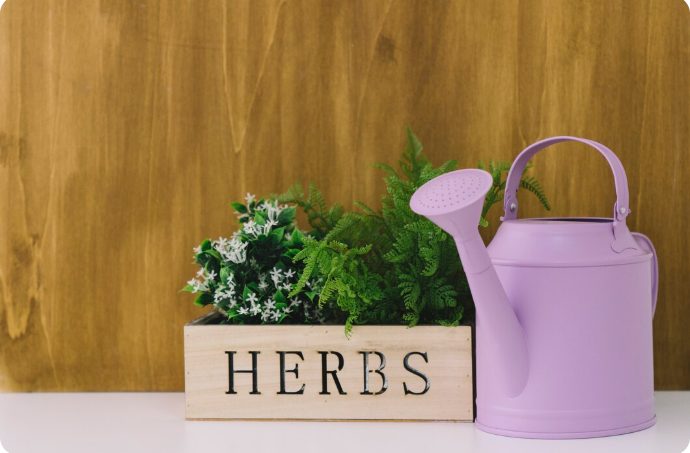
Fresh herbs don’t belong only in outdoor gardens. You can grow them right in your kitchen, living room, or even on a sunny windowsill.
With a little creativity, a few pots, and the right setup, it’s easy to grow herbs indoors all year round.
Basil, mint, rosemary, and thyme add more than flavor—they add color, scent, and charm to your space.
A small herb garden can fit on a shelf, hang on a wall, or sit neatly on a countertop. Some setups even double as stylish decor.
These indoor garden ideas work well for apartments, small homes, or anyone who enjoys fresh ingredients close at hand.
Simple, smart, and space-saving, each idea in this list can help you enjoy fresh herbs without needing a big backyard.
Explore these 10 indoor herb garden ideas and bring a touch of green—and flavor—into your daily life.
10 Indoor Herb Garden Ideas That Are Simple and Stylish
Growing herbs indoors can make cooking more fun and healthy. Fresh herbs bring flavor, color, and a nice smell into your home.
You don’t need a big backyard or a large kitchen. A few small spaces and a little sunlight can work just fine.
These 10 indoor herb garden ideas are easy to set up, easy to care for, and perfect for small homes, apartments, or even dorm rooms.
Let’s explore these simple and creative ideas to grow your own herb garden indoors.
1. Mason Jar Herb Garden
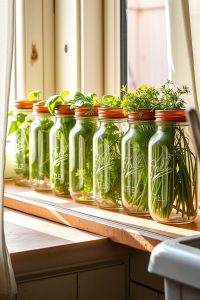
Mason jars make cute and useful containers for growing herbs. You can place them on a windowsill, shelf, or even hang them on a wall.
Herbs like basil, mint, and parsley grow well in jars. To make this garden, add small stones at the bottom for drainage.
Then fill the rest with potting soil and plant your herb seeds or small plants.
Make sure the jars get sunlight for at least six hours a day. Water them just enough to keep the soil moist.
2. Hanging Herb Planters
Hanging planters save space and look nice too. You can hang them from the ceiling, under cabinets, or on wall hooks.
This type of garden works well in kitchens with limited counter space.
Choose lightweight pots and hang them with strong ropes or chains. Herbs like oregano, thyme, and mint grow well in hanging pots.
Make sure they are easy to reach for watering and trimming.
3. Wall-Mounted Herb Garden
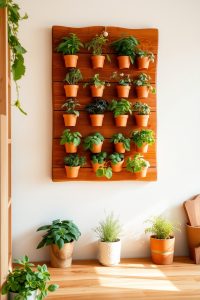
A wall-mounted garden turns an empty wall into something useful. You can use wooden pallets, metal grids, or pocket planters.
This type of setup keeps herbs off the floor and adds green to your space.
Mount small pots or planters directly onto the wall. Herbs like chives, rosemary, and sage grow well this way. Place the setup near a sunny window for best results.
4. Windowsill Herb Garden
A windowsill gets good natural light and is close to your cooking space. That makes it perfect for a small herb garden.
Use narrow containers or small pots that fit the space. Herbs like basil, dill, and coriander love the sun.
Line them up and rotate them once in a while so each side gets equal light. Water when the soil feels dry on top.
5. Tiered Herb Planter
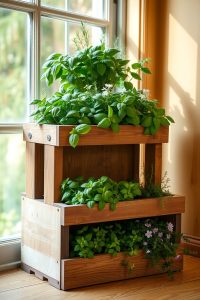
A tiered planter lets you grow several herbs in one place without using much space. It also makes it easy to water and care for each plant.
These planters come in wood, metal, or plastic styles. You can place a tiered planter near a window, balcony door, or in a bright hallway.
Plant parsley, thyme, rosemary, and basil in different levels.
6. Recycled Can Herb Pots
Old cans from soups, beans, or tomatoes can become great herb containers. Clean them well, punch holes at the bottom for drainage, and paint or decorate the outside.
Place the cans on a tray or small shelf. Grow herbs like chives, cilantro, and oregano. This is a budget-friendly idea and good for recycling too.
7. Countertop Herb Garden Kit
Some people like to use ready-made herb kits. These come with everything—seeds, soil, and pots. They are easy to set up and fit well on kitchen counters or tables.
Many kits even include grow lights, so you don’t need a sunny window. Use them for herbs like basil, thyme, and mint. These kits make indoor gardening very simple.
8. Wooden Crate Herb Box

Wooden crates offer a rustic look and enough space for a small herb garden. You can place them on the floor, shelf, or table.
Add small plastic liners or pots inside to protect the wood from water.
Herbs like sage, parsley, and basil grow well in crates. Label each herb with a small tag for easy care.
9. Magnetic Herb Jars on Fridge
Use magnets to turn your fridge into a mini herb garden. Attach strong magnets to the back of small jars or tins.
Fill them with soil and herb plants, then stick them on the fridge.
Grow herbs like thyme and oregano this way. It saves space and adds a fun, creative touch to your kitchen.
10. Indoor Hydroponic Herb Garden
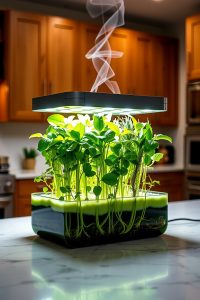
Hydroponic gardens grow herbs in water, not soil. These systems often use LED lights and need less work than soil gardens. They are clean and mess-free.
You can grow herbs like basil, mint, and cilantro in these systems. Just add water and nutrients, and the plants grow fast.
Place the system near a power outlet and enjoy fresh herbs anytime.
FAQs
How much sunlight do indoor herbs need?
Most herbs need about 6 hours of sunlight a day. A sunny windowsill or grow light can help.
What herbs grow best indoors?
Basil, mint, parsley, thyme, chives, oregano, and rosemary grow well indoors.
How often should I water indoor herbs?
Water when the top of the soil feels dry. Don’t let the soil stay too wet or too dry.
Can I grow herbs indoors without sunlight?
Yes. Use grow lights to give your herbs the light they need.
Do herbs need special soil?
Use light potting soil with good drainage. Avoid heavy garden soil.
Can I grow herbs from kitchen scraps?
Yes. You can regrow herbs like green onions and mint from cuttings.
Conclusion
Indoor herb gardens bring life and flavor into your home. They are easy to care for, don’t take much space, and look beautiful too.
With the ideas shared here, anyone can start growing herbs in a small kitchen, apartment, or even a dorm room.
Pick the style that fits your space. Add some fresh green to your daily life. Let your herbs grow close to where you cook, eat, and relax.
